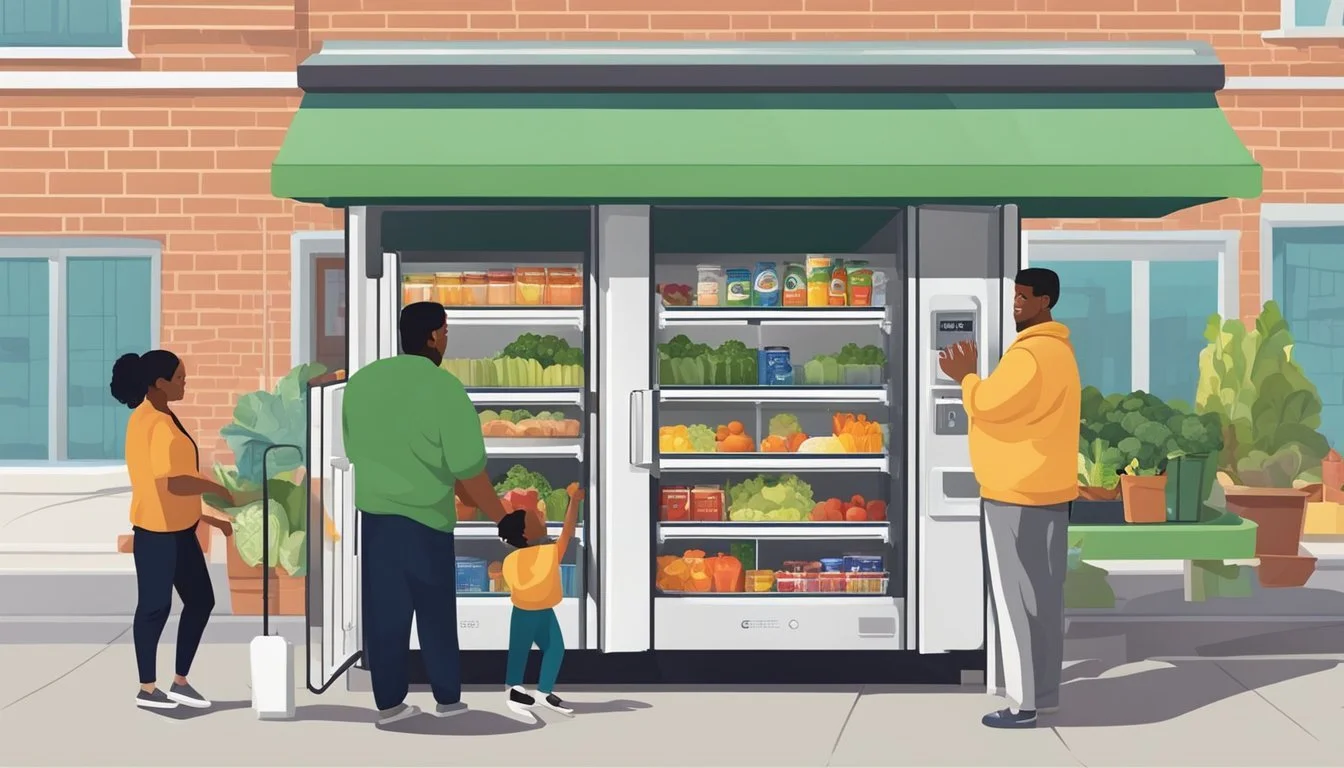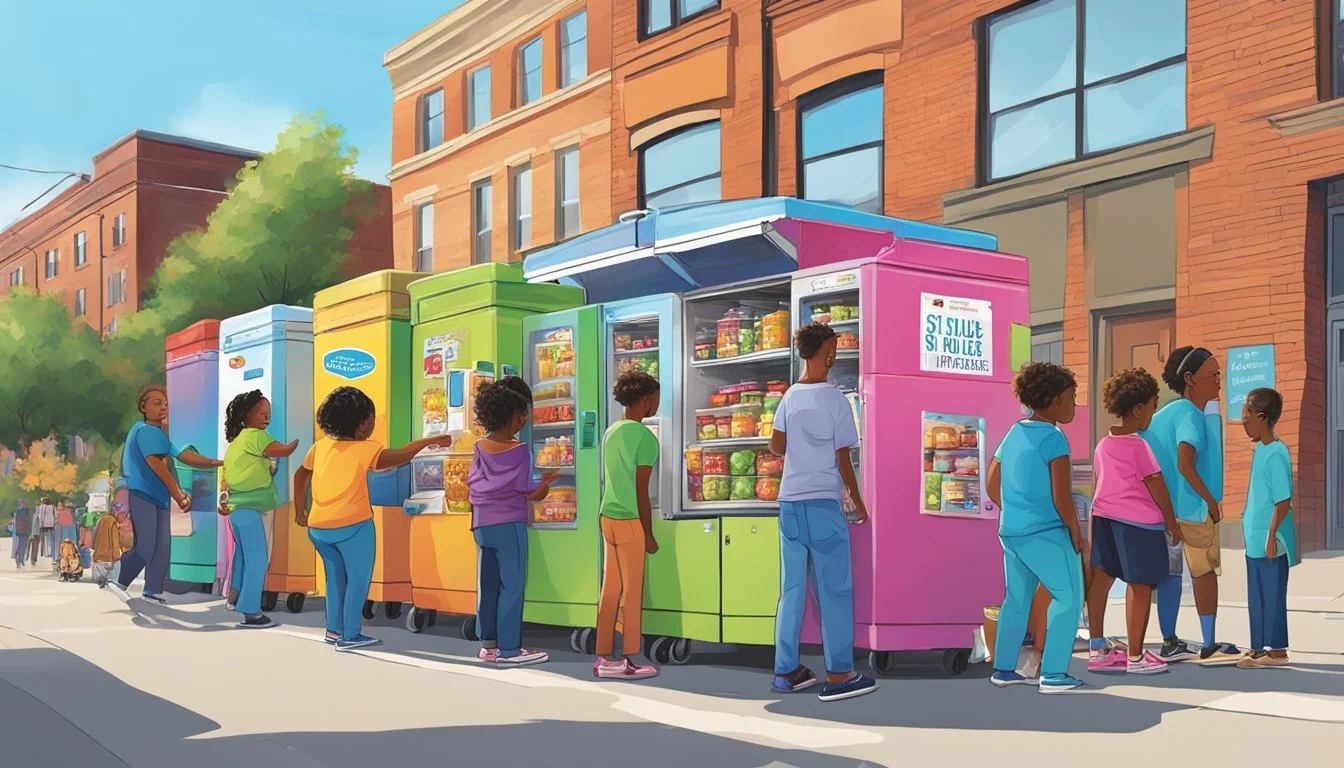St. Louis, MO Community Fridge
Addressing Food Insecurity with Compassion and Innovation
In Saint Louis, Missouri, community fridges have emerged as an innovative solution to food insecurity and food waste. These refrigerators are placed in accessible public areas, allowing residents to take what they need and give what they can, operating on an honor system. The community fridges not only provide perishable food items to those who might not have consistent access to fresh produce and other staples but also contribute to a significant reduction in food waste.
The local community has recognized the potential impact of community fridges, as evidenced by the redistribution of large quantities of food that might have otherwise gone to waste. In a span of just three months, statistics show that a single fridge can redistribute multiple tons of surplus food. This effort translates into substantial savings for households and community groups, which can exceed tens of thousands of dollars in food costs.
These initiatives are sustained through the collaborative efforts of volunteers, donors, and civic organizations, which are dedicated to supporting citizens facing food insecurity. Saint Louis community fridges represent a practical and compassionate step toward creating a more food-secure city, while also fostering a spirit of sharing and caring within the community.
Origin and Global Impact
The concept of the community fridge originated in Europe and rapidly spread across various countries, becoming a global movement to reduce food waste and provide community support.
Beginnings in Spain and Germany
Spain and Germany were pioneers in the community fridge movement, known locally as 'solidarity fridges' and 'honesty fridges,' respectively. These fridges initially emerged as a response to combat food waste, while simultaneously aiding those in need. The fridges are placed in accessible public areas, allowing people to leave surplus food and for anyone in need to take what they require, no questions asked.
Expansion to UK and Ireland
The community fridge network soon extended to the UK and Ireland, with numerous fridges installed in towns and cities. These setups took on both environmental and social roles, not only reducing food waste but also fostering a sense of mutual aid and community.
Growth in the U.S.
In the U.S., community fridges have been widely adopted in cities and suburbs alike. They serve as neighborhood resources where residents can access fresh food for free, embodying the ethos, "Take what you need, leave what you can." Notable in this expansion is the Community Fridge Saint Louis, which has made significant strides in redistributing surplus perishable foods and saving households money.
Community Fridge Networks Worldwide
The community fridge initiative has evolved into a global network, with the nonprofit database Freedge offering a comprehensive map of community fridges worldwide. The growth trajectory of these networks illustrates a collective commitment to food solidarity, reducing waste, and building resilient localities.
St. Louis Community Fridge Efforts
In St. Louis, the initiative to combat food waste and provide food accessibility to the community has led to the establishment of community fridges. These fridges serve as a nexus for local businesses and community members to support those in need.
Location and Accessibility
Community fridges in St. Louis are located in accessible public spaces, ensuring that individuals from all walks of life can reach them without barriers. One popular fridge is situated at the Urban Roots Farm, located at 823 W State St. These locations are strategically chosen to maximize convenience for residents across the city, fostering a network of support and food sharing.
Community Participation and Support
The success of community fridges relies heavily on community participation and support. St. Louis residents embrace the honor system that underpins the fridge's operation. Over several months, one community fridge can redistribute substantial amounts of food waste and provide considerable savings to households and community groups. The engagement from local community drives the effectiveness of these fridges in delivering their mission.
Local Business Contributions
Numerous local businesses have stepped forward to bolster the community fridge movement. By donating perishable food items that would otherwise go to waste, these businesses play a critical role in the sustenance of the project. Their contributions not only address food insecurity but also represent a collective business commitment to community welfare and sustainable practices.
Benefits and Challenges
Community fridges in St. Louis, MO, serve the dual purpose of reducing food waste and providing food security. However, they face the hurdle of aligning with local laws and regulations, which can pose significant challenges.
Reducing Food Waste
St. Louis community fridges have demonstrated their ability to significantly reduce food waste by redistributing surplus perishable goods. They turn potential waste into valuable resources for the community. For instance, in a period of three months, a single fridge can redirect 12 tons of food, which otherwise might end up in landfills.
Supporting Food Security
These fridges directly combat food insecurity by making essentials freely accessible to all. The food comes from donations, often sourced from surplus food that retailers, restaurants, and individuals have. They essentially save households and community groups substantial amounts of money, in some instances reportedly in excess of $10,000 in food costs.
Navigating Local Laws and Regulations
Compliance with local laws and regulations is a complex but necessary task for the operation of community fridges. The legal landscape involves ensuring food safety and public health standards are met. This can include regular checks, cleaning schedules, and proper labeling of food. Maintaining the balance between the free distribution of food and adherence to local laws can be a delicate process for community fridge organizers.
Managing a Community Fridge
A Community Fridge in St. Louis, MO, must adhere to structured health and safety measures, operate on a community-based honor system, and effectively utilize social media platforms such as Instagram for outreach and engagement.
Health and Safety Protocols
The management of a Community Fridge prioritizes health and safety for all participants. They must ensure that the fridge is consistently cleaned and sanitized. A five-step guide is in place, which includes regular checks for expired items and maintaining proper food temperatures. Applicable local health regulations need be strictly followed to prevent foodborne illnesses.
Operating on the Honor System
The Community Fridge operates on the honor system, trusting individuals to take what they need and give what they can. This system fosters community trust and shared responsibility. To ensure transparency and fairness, clear guidelines are displayed prominently on or near the fridge, indicating best practices for food sharing and safety.
Engaging with Social Media
For effective outreach, St. Louis Community Fridge managers regularly engage with the public via Instagram and other social media platforms. These tools are used to share updates, celebrate community stories, and disseminate essential information. A steady stream of content helps in maintaining public interest and in encouraging widespread community participation.
Future Prospects and Developments
The St. Louis Community Fridge initiative is poised for significant strides, with advancements in technology, expansion of collaborative networks, and an emphasis on sharing practical experiences to drive its success.
Technological Innovations
St. Louis Community Fridges are expected to incorporate technological advancements to enhance food preservation and reduce waste. The use of IoT sensors will monitor food temperatures and inventory in real-time, ensuring food safety and optimizing stock levels.
Collaborative Networks and Expansion
The initiative is set to expand through collaborative networks that include local businesses, nonprofits, and community leaders. These partnerships will focus on establishing more fridge locations to address food insecurity. Each community fridge serves as a hub for community support, fostering a shared responsibility towards nurturing communal wellness.
Current Locations: Aiming to double.
Goal: Extend coverage to underserved areas.
Partnerships: Local businesses, education institutions, community organizations.
Sharing Experiences and Best Practices
Sharing experiences is crucial for the initiative's improvement and sustainability. Documenting and disseminating best practices will empower new communities to launch their own fridges effectively. It will also foster an environment of mutual learning, ensuring that community fridges across the network operate efficiently and respond to the specific needs of their neighborhoods.
Documentation: Success stories, troubleshooting, operational guidelines.
Knowledge Sharing: Workshops, online forums, community meetings.







